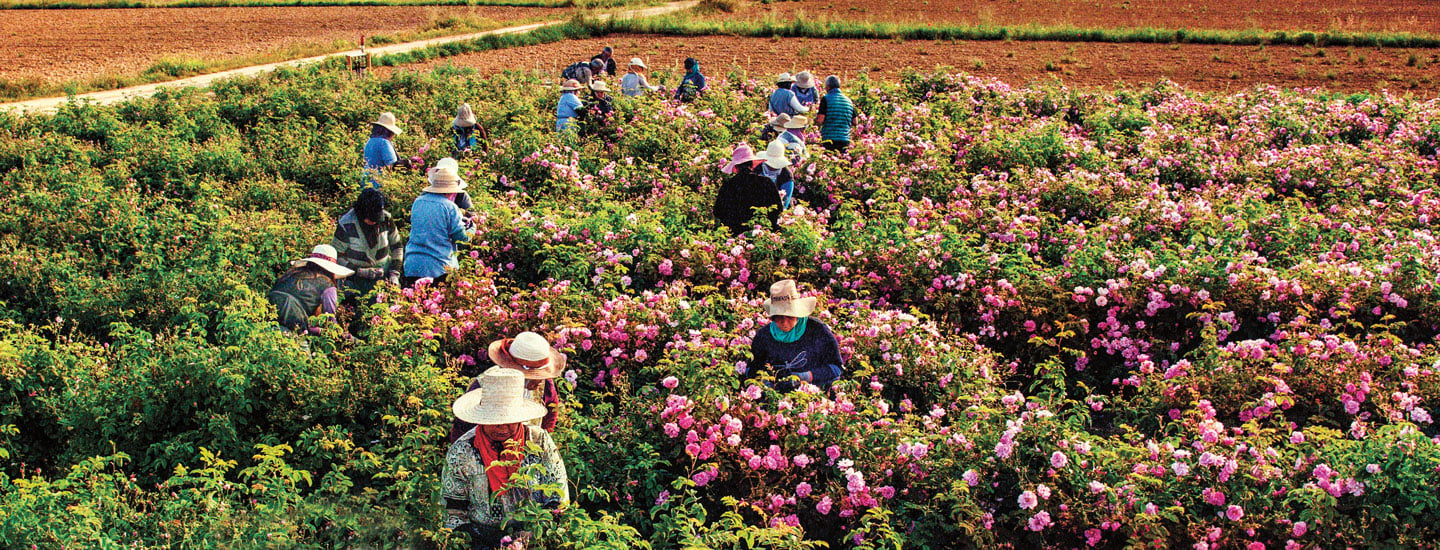HEKLA/SHUTTERSTOCK.COM
END RESULT: A perfume may contain the scent of many flowers.
Each spring, 70 workers descend upon the rose fields of Pégomas, France. Every day for two weeks, they’ll rise at dawn to harvest fragrant roses by hand. By the time their work is done, they will have picked about 37 tons of flowers—an amount comparable to the weight of five full-grown elephants.
The flowers are placed in burlap sacks and taken to a nearby factory within an hour of being plucked. Wait any longer and the molecules—two or more atoms chemically bonded together—responsible for the roses’ honey-like scent begin to break down. As soon as the petals arrive at the factory, they’re tossed into a chemical bath and heated. The liquid chemicals evaporate into a gas, leaving behind a wax that smells like a Pégomas rose (see From Rose to Perfume). A fragrant oil extracted from the wax will become the main ingredient in Chanel No. 5—one of the most popular perfumes of all time.
Each 30 milliliter (1 fluid ounce) bottle of Chanel No. 5 contains the concentrated scent of about 12 roses, along with dozens of other fragrant ingredients. The resulting aroma does more than just smell good. Scent is strongly linked to memory and emotion. Just one whiff of a perfume can evoke a different time, place, and feeling in your mind. For perfumers to create such compelling scents, they must rely on their noses—and chemistry.
Each spring, 70 workers head to the rose fields of Pégomas, France. They rise at dawn to pick sweet-smelling roses by hand. They’ll work every day for two weeks. When they’re done, they will have picked about 37 tons of flowers. That’s about the weight of five full-grown elephants.
Workers place the flowers in burlap sacks. Certain molecules—two or more atoms chemically bonded together—give the roses their honey-like scent. The flowers are taken to a nearby factory within an hour of being picked. Wait any longer, and these molecules begin to break down. As soon as the petals arrive at the factory, they’re tossed into a chemical bath and heated. The liquid chemicals evaporate into a gas. That leaves behind a wax that smells like a Pégomas rose (see From Rose to Perfume). A fragrant oil is removed from the wax. It will become the main ingredient in Chanel No. 5. That’s one of the most popular perfumes of all time.
A bottle of Chanel No. 5 might hold only 30 milliliters (1 fluid ounce). But it contains the concentrated scent of about 12 roses, plus dozens of other fragrant ingredients. That creates a scent that smells good, but it does more. Scent is strongly linked to memory and emotion. One sniff of a perfume can make you think of a different time, place, and feeling. To create such appealing scents, perfumers must rely on their noses—and chemistry.


 The roses are handpicked during a two-week period in the spring when they are in full bloom.
The roses are handpicked during a two-week period in the spring when they are in full bloom. The rose petals are dumped into a vat of a chemical called hexane and heated. The hexane helps draw out fragrant substances from the flowers.
The rose petals are dumped into a vat of a chemical called hexane and heated. The hexane helps draw out fragrant substances from the flowers. Workers remove the flower petals. Further heating causes the liquid hexane to evaporate into a gas. That leaves behind a rose-scented wax.
Workers remove the flower petals. Further heating causes the liquid hexane to evaporate into a gas. That leaves behind a rose-scented wax. The wax is sent to Chanel’s lab, where it is processed into an oil called an absolute, which can be put into a perfume.
The wax is sent to Chanel’s lab, where it is processed into an oil called an absolute, which can be put into a perfume. A master perfumer smells the oil and other natural and synthetic ingredients to determine the best mix for the perfume.
A master perfumer smells the oil and other natural and synthetic ingredients to determine the best mix for the perfume. The ingredients are diluted, or thinned out, by adding an alcohol called ethanol. Then the perfume is bottled and shipped out for sale.
The ingredients are diluted, or thinned out, by adding an alcohol called ethanol. Then the perfume is bottled and shipped out for sale.